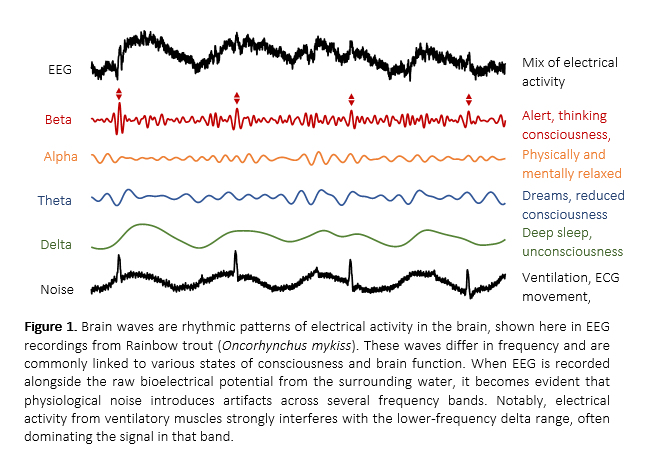FISHING FOR BRAINWAVES: HOW TO CATCH A CLEAN EEG SIGNAL WITHOUT GETTING TANGLED IN NOISE
Background
The growing recognition of fish as sentient beings has led to increased attention to fish welfare in both aquaculture and wild capture contexts. A key area of concern is the period of stunning and killing, where ensuring unconsciousness prior to death is critical for securing humane treatment of animals. Humane killing is not only an ethical imperative but also a foundational principle in animal welfare legislation. In this context, the European Food Safety Authority (EFSA) highlights the use of neurological indicators obtained via electroencephalography (EEG) as the gold standard for assessing the effectiveness of stunning. Nevertheless, commercial practices often rely on operational indicators such as cessation of movement or loss of equilibrium. Emerging evidence suggests that these signs can be misleading; in many cases, fish may appear immobile while EEG recordings reveal ongoing brain activity indicative of consciousness (van de Vis et al., 2003). This discrepancy underscores the urgent need for reliable, objective tools to assess stunning efficacy.
Material & Methods
To address this need, we adapted EEG methodologies established in humans to develop a non-invasive technique suitable for use across several fish species. Our setup employs a silicon suction cup to attach plate electrodes securely to the head of the fish, ensuring stable contact without surgical implantation. This approach enables us to record cortical electrical activity with minimal interference to the animal (Brijs et al. 2021; Hjelmstedt et al. 2022). However, EEG recordings in fish are prone to signal contamination. External noise sources include electrical interference from surrounding equipment, variability in electrode material, and characteristics of connecting wires (e.g., shielding, length). Physiological noise, such as muscle contractions, cardiac activity, and respiratory movements, further complicates signal interpretation. These artifacts can mask or mimic genuine neural activity, increasing the risk of misinterpretation.
Results
Through controlled laboratory trials, we evaluated and reduced noise from external sources by optimizing equipment setup, electrode placement, and shielding. This improved baseline signal quality and reduced variability. Physiological artifacts presented more complex challenges. Our data demonstrate that muscle activity can dominate the EEG trace (Figure. 1). For example, ventilatory muscle activity can introduce low-frequency artifacts that may bias interpretations, especially in stunned but not fully unconscious fish. To improve reliability, we incorporated event-related potentials (ERPs), specifically visual evoked responses (VERs), into our assessments. Unlike spontaneous EEG, ERPs are time-locked to external stimuli, allowing for averaging over time to reduce background noise. Our findings show that VERs provide a robust method for detecting unconsciousness, as they reflect whether external stimuli are still being processed by the brain. This technique significantly enhances the interpretability of EEG data under noisy conditions.
Conclusions
Our work highlights the risk of misinterpretation when EEG recordings are evaluated without accounting for noise and artifacts. This is particularly critical in the context of animal welfare assessments, where the consequences of false-negative or false-positive conclusions about consciousness are ethically significant. As EFSA recommends, combining spontaneous EEG analysis with ERP-based assessments significantly enhances reliability and should become standard practice in evaluating fish stunning methods. To move this field forward and establish EEG-based methods as credible tools for welfare assessment, we must also raise the bar for methodological transparency and rigor. By ensuring this level of detail and standardization, we can promote reproducibility, facilitate cross-study comparisons, and build a stronger scientific foundation for evidence-based fish welfare policy. Ultimately, EEG-based assessments, when combined with ERP methodologies and conducted with high methodological precision, offer a powerful approach to objectively and ethically evaluate stunning efficiency in fish. These tools not only serve scientific progress but also address growing societal and regulatory demands for transparency and compassion in animal handling.
References
Brijs, J., Sundell, E., Hjelmstedt, P., Berg, C., Senčić, I., Sandblom, E., Axelsson, M., Lines, J., Bouwsema, J., Ellis, M., Saxer, A., & Gräns, A. (2021). Humane slaughter of African sharptooth catfish (Clarias gariepinus): Effects of various stunning methods on brain function. Aquaculture, 531, 735887.
Hjelmstedt, P., Sundell, E., Brijs, J., Berg, C., Sandblom, E., Lines, J., Axelsson, M., & Gräns, A. (2022). Assessing the effectiveness of percussive and electrical stunning in rainbow trout: Does an epileptic-like seizure imply brain failure? Aquaculture, 552, 738012.
van de Vis, H., Kestin, S., Robb, D., Oehlenschläger, J., Lambooij, B., Münkner, W., Kuhlmann, H., Kloosterboer, K., Tejada, M., Huidobro, A., Otterå, H., Roth, B., Sørensen, N. K., Akse, L., Byrne, H., & Nesvadba, P. (2003). Is humane slaughter of fish possible for industry? Aquaculture Research, 34(3), 211–220.
